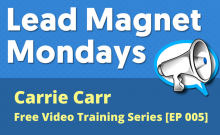There was a guy who used to always glare at me in my high school calculus class…
As soon as the teacher called on me, he would slowly turn around in his front row seat and shoot me a look of disbelief and exasperation.

Come on… why do you have to ask ANOTHER question?
Yeah, yeah. I get it. I asked a lot of questions in that class.
But usually, my question had to do with an alternative solution I had discovered for the problem on the board.
I had gotten the same answer, but I went about my process in a backwards way from how the teacher was showing us.
Was my way correct? Was it okay to approach the problem the way I had?
The answer was almost always yes.
I did things backwards, but I was usually right… and earned an A in the class.
When it comes to marketing, this trend of doing things a bit backwards continues. You see, many marketers focused their early efforts on the really big problems: How to make more sales, How to craft the right copywriting message, How to market the business.
I, on the other hand, got into the world of direct response marketing as a humble researcher…
My very first clients hired me to do deep-dive research into their market’s hopes, dreams, and beliefs. It was during this period of time that I learned that backwards isn’t bad.
Looking at a prospect or product from a different angle is the key to finding creative and effective selling promotions. Ones that hit on specific and intimate feelings or connections with your prospect. It’s the key to finding special selling triggers that instantly click with your prospect so they are excited to buy from you over and over again.
To put it simply…
Research is VERY important.
Without a strong sense of your ideal prospect — aka your “avatar” — you are left spinning your wheels with no real sense of direction… and few sales to show for your efforts.
Marketing great David Ogilvy said, “Find out all you can about your prospect before you call on them: their general living conditions, wealth, profession, hobbies, friends and so on. Every hour spent in this kind of research will help you impress your prospect.”

At the beginning of a research project, I like to think of an avatar like one of those backlit silhouettes on a crime show documentary. You can’t see their face and their voice has been disguised with an electronic recorder.
Over time, good research will shed light onto your mystery person…
First, showing their face. Then, illuminating their voice, revealing their clothing, giving a glimpse into their lives.
By the end of your deep-dive research, you know your prospect so well you could sit down with them over a cup of coffee and talk like besties.
Solid avatar research will help you learn their innermost feelings, beliefs and desires. It will help you discover the words, facts, and phrases that are likely to encourage, frighten or excite them.
You’ll unlock the magic words and selling triggers that will turn them into loyal customers who want to buy from you forever.
There a few ways to start shedding light on your mystery avatar…
1. Investigate your product.
A well-designed product is going to start with a need in the marketplace.
For instance, why create a course for a certain skill set if there aren’t already people out there looking for that solution? Why create a new gadget for gardening if there aren’t already people out their who would benefit and line up to buy?
If your product doesn’t have a matched market who would be interested in your solution, then you are fighting a losing battle from the very beginning.
Dan Kennedy’s marketing triangle says you need to match the market (who) with your message (what) and media (how).
So, take a look at your product and think about what type of buyers would be attracted to the solution you offer. Then, it’s just a matter of coming up with the right messaging and media to share your offer and attract buyers.
2. Ask your prospects.
If you already have an existing list of buyers, then this is a great time to take a hard look at the common traits that you unite people who have purchased your product. Send them a survey or use the techniques from Ryan Levesque’s ASK Method to uncover exactly what your buyers want.
If you don’t have an existing list, you can often find some really great information about your potential prospects in online communities, forums, and chat groups. Use this opportunity to study the language your prospect is using so you can talk to them as if you are “one of them.” The right language will trigger a feeling of trust. You’re part of their community so they will know you understand their thoughts, feelings, hopes, and desires.
3. Look at past promotions.
Another way to learn about your prospect is by looking at past promotions or offers (either for your product or for competitors) that have worked or flopped. What are the common themes in promos that worked? Did they touch on certain emotions or common enemies? Did they use certain tones or language that would connect the prospects?
A simple example of this might be found in two promotions for a health supplement…
Promotion A focused on the fact that the FDA-approved prescription drugs were killing Americans year after year. The piece appealed to readers who were suspicious of the government and looking for a solution. It performed very well.
Promotion B was for the same product, but focused on the “all-natural” and green ingredients in the product. The readers didn’t seem to care about this selling feature and the promotion didn’t do very well at all.
After analyzing these two promotions, you can learn that using the common enemy of “the government” is a better way to connect and attract prospects to this particular product.
I’ve put together these two checklists to help you cover some of the most important things to research so you can unlock those selling triggers that will turn your promotion into a success.
Grab a Google Doc version of these checklists here.
Checklist to Shed Light on Your Avatar
- What are the demographics of your absolutely perfect prospect? Get as much information as you can. What is their typical age, gender, income, educational level, home ownership status, location, and family structure?

- What are the biggest problems your prospects are facing each day? Think deep. Try to find the problems that are keeping them up every night… problems that are strongly associated with emotions.
- Once you have their problems, think about what magical solution would solve everything for them? Is this something your product can provide?
- What are some common objections your prospect may have for your type of product or service? Knowing these ahead of time will give you an opportunity to address those objections head-on in your marketing.
- Who are the common enemies your prospects don’t like? In your marketing you can commiserate with them on these enemies. Enemies don’t have to be people. They could also be situations or problems that everyone seems to face.
- What language is your prospect speaking? I’m not talking about English versus French. Instead, try to identify slang terms or ways of speaking that help people in your prospect’s community identify who is “in” and who is “out.” Then, be sure to speak as if you’re “in.”
- Who are your competitors? Looking at what is working for other marketers in your industry can be a powerful way to identify what types of sales messages would work and what wouldn’t.
- Thinking about your prospect’s “loves and hates”… try to identify the books they love, media they are consuming, hobbies they participate in, and groups they belong to.
Crafting an effective sales message for your product — one that appeals to your prospect — may mean you need to think about your product on a deeper level. This checklist guides you through the process…
Take a Hard Look at Your Product
- What’s your product or service’s origin story? Is it interesting and unique? How can you use this to your advantage and appeal to your prospect?
- Why does your product or service make sense for the buyer? Is it going to save them time, money, stress, or solve one of their biggest problems? What is their ROI (return on investment)?
- What is your Unique Selling Proposition (USP)? Why is it about your product or service that makes it so your buyer should buy from you over any and all other solutions or products available to them?
- What are some current news issues or problems facing your prospect in the world today? Things like political climate, weather events, recent technological advancements, or pop culture trends can play a role in how your product or service performs.
- How much does your product or service cost? Can you justify this cost by comparing it to how much they would spend by continuing to do without your product for a future period of time? For instance, getting LASIK eye surgery feels expensive until you understand the cost savings of eye insurance, contact purchases, and lens solution over a period of several years.
- Is there a deadline to take advantage of your offer? Are their specific guarantees, bonus, or special offers that would influence your buyer’s decision to take advantage of the offer today rather than waiting a few months to purchase?
- How exactly is your product or service going to solve a problem for your prospect? Link this solution to your prospect’s deepest hopes, fears and desires.
Grab a Google Doc version of these checklists here.
Use these techniques and checklists to dig deep into your prospect and product so you can unlock those specific selling triggers to make your promo a raging success!
Ready to create your own kick butt lead magnet?
Drop me a line at rkraft@kraftedonline.com and I can help you finally turn your lead magnet ideas into a reality. Have me work side-by-side with you to strategize, write, and design your product. Or, hand over the reins and I’ll take the entire job off your plate.







Leave a Comment
You must be logged in to post a comment.